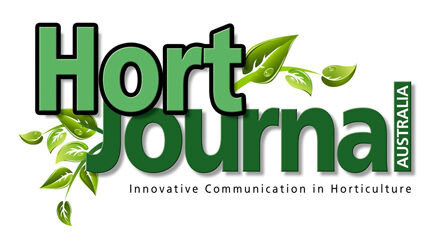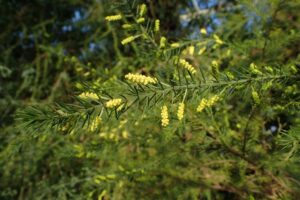Guess who’s coming for dinner?
By Gabrielle Stannus
While your clients sleep, their gardens may attract unwanted guests looking for a late-night feed. Australia’s many nocturnal animals are attracted to native plants and those exotic species we humans love for their edible and ornamental value. I spoke with Beverley Sherwood, Manager of the Plants of Tasmania Nursery, to find out how physical barriers, plant selection, and placement can help landscape designers and horticulturists discourage these unwanted visitors from the gardens we design and create.
The Plants of Tasmania Nursery has grown Tasmanian native plants since 1990 at Ridgeway, a rural/residential area approximately seven kilometres southwest of Hobart. Therefore, Beverley Sherwood knows a thing or two about protecting plants from grazing wildlife in a commercial setting, and her knowledge extends to home gardens, especially those located on the growing fringes of our cities and towns and in rural areas.
“We mostly use physical barriers in the nursery to deter wildlife from eating our stock,” says Beverley, “In growing areas in the retail section, we are limited on bench space. So, we place plants that wildlife like to eat either in a caged area or at a height they cannot reach. Out in the production areas, we also place plants on benches. However, not only can the possums get up on the bench now, but the pademelons or the wallabies seem to have figured that out too! We are having our fencing redone because the animals here have a fairly ‘come and go as you please’ attitude to the nursery. I think the wallabies and possums, especially this year, with it being so dry here, are just ravenously hungry. We have customers coming in saying that their agapanthus is being eaten, and that is almost unheard of.”
Beverley says that greater grazing pressure will undoubtedly occur during periods of low food availability in the bush. Many of our country’s original fauna are opportunistic and do not restrict their grazing to native plants. The Eastern Grey Kangaroo (Macropus giganteus) ranges from the Cape York Peninsula to Tasmania where it is commonly called the Forester Kangaroo. These predominantly nocturnal grazing animals favour young green grass shoots high in protein1. However, they will eat a range of plants. According to the Foundation for National Parks and Wildlife, eucalyptus leaves are the common ringtail possum’s (Pseudocheirus peregrinus) favourite food2. However, both ringtail and common brushtail possums (Trichosurus vulpecula) will also eat flowers, fruits and vegetables, including roses, gardenias, fuchsias and passionfruit.
Fence to defend
In last month’s Hort Journal, I wrote about netting fruit trees safely to protect those edible plants whilst avoiding harm to Australia’s unique fauna (‘Crop protection: Wildlife’s safety net’). However, Beverley says that the best way to stop kangaroos, wallabies, and possums from eating plants is to physically exclude them from entering a garden in the first place. A well-made tin or paling fence (with the frame on the inside and the palings butted but not overlapped) about 1.5 m high will keep possums, wallabies and most smaller kangaroos out of a garden. Common brushtail possums readily climb fences but can only jump about one metre vertically and cannot climb sheer walls3 .
If constructing a fence from wood, include a tin section at least 33 cm wide and 80 cm from the ground around each fence corner to stop possums from climbing up. If using steel mesh, ensure it has enough strength and rigidity to prevent moving wallabies or wombats from damaging it, and so smaller wallabies cannot move through gaps4. Include a gate for animals to leave easily should they enter the property5. Stop animals pushing or digging under a fence by including an apron or footer at least 400mm deep. If the fence is to enclose a larger rural property, consider including a high-powered, well-maintained hot wire 125mm off the ground instead4. A footer or apron at the base of the fence can effectively stop wallabies going under, whereas barbed wire at the fence’s base will not. It will also deter burrowing creatures such as wombats entering the garden.
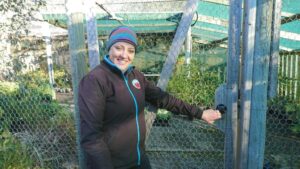
Combat the wombat!
Even if wombats do not eat the plants in your client’s garden, they may open a garden to other ‘critters’ who will, including our fleet-footed jumping friends, i.e. macropods. Wombats can dig under a footer or apron if they find a weak spot. Here in Tasmania, I am ‘lucky’ enough to have the common wombat (Vombatus ursinus) visit our garden regularly. The common wombat also resides in southern Queensland, eastern New South Wales and eastern Victoria, with remnant populations found in south-eastern South Australia and south-western Victoria.
Wombats are mostly nocturnal, solitary animals, usually coming out at night to graze when temperatures are lower6. Their herbivorous diet consists mostly of fibrous native grasses, sedges and rushes; however, their choice of food depends on what is available at the time7. We recently caught one wombat having a red-hot go burrowing its way into our produce enclosure, which we have constructed to stop mainly wallabies and possums entering to eat our vegetable garden. A footer stopped this wombat’s progress initially. However, this individual recently found an entry in a corner where the mesh had come loose. We found it sitting on the garden path chilling out under the moonlight and were lucky that it had yet to start eating our crops.
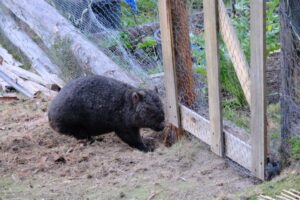
Create a botanical barrier
In some situations, you may be able to seal off a garden area more cheaply through other means than more traditional fencing and caging. “Planting lots of eucalypts around your property’s border can put off wallabies, especially if you keep them low and bushy and make a prominent screen out of them,” says Bevereley, “Trees that fit this bill include Eucalyptus globulus (Tasmanian Blue Gum), Eucalyptus cladocalyx ’Nana’ (Dwarf Sugar Gum) and other mallee-form eucalypts that can be coppiced. You can also make a natural barrier using dense shrubs such as Acacia verticillata (Prickly Moses), which can be underplanted with species that wildlife does not like to eat. I use lomandras and dianellas at home, especially Dianella tasmanica (Tasman Flax Lily). Once they are well established, not even sheep all that keen on eating Lomandra longifolia (Spiny-headed Mat-rush).” Note though that this approach may not discourage climbing possums! Before designing their garden or landscape, find out what wildlife is living in and around your client’s site.

Select to deflect wildlife
Careful consideration of plant traits when selecting and placing plants can reduce wildlife’s impact on your client’s garden. Some plants’ biological, chemical and physical traits may deter native wildlife from coming into contact with them. These traits may make those plants features within their own right or help protect other plants in a garden. Possums, for example, do not like aromatic plants, such as chrysanthemums, mint bushes, geraniums and daisies, or spiky plants such as spiny grevilleas and hakeas, or tough, woody banksias2. “Plants that are spiky like Prickly Moses can be used to protect other plants from native wildlife. Plants that have strong oils or fragrances tend to be quite off putting to animals,” adds Beverley.
Trichomes can deter herbivores by secreting deterrent chemicals or through physical irritation, as can other hairs on plant parts. “Lasiopetalum macrophylum (Prostrate Velvet Bush) is a pretty good ground cover. The wildlife has not nibbled that at my place, and they leave it alone in the nursery. Our theory is that it is not that pleasant on their tongue,” says Beverley. This ornamental subshrub grows to around 20cm tall and can spread up to 2m. L. macrophyllum possesses attractive soft bronze-coloured foliage. It has rusty brown stellate hairs, i.e. covered with star-like projections, on its stems, leaves and sepals8, which might be the reason why wildlife is discouraged from eating it.
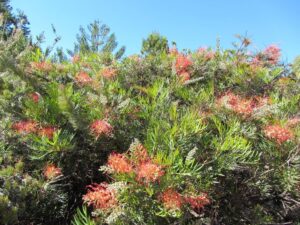
Similarly, Beverley theorises that wildlife avoids what she calls ‘mainland’ grevillea species known to cause contact dermatitis in florists. The foliage of several grevilleas is known to cause skin irritations to humans, most notably the “Robyn Gordon” group of cultivars9. The derivative of the allergen resorcinol in grevilleas is very similar chemically to urushiol, the sensitising agent in the genus Toxicodendron, which includes Poison Ivy (T. radicans)10. If placing these plants in a garden to discourage wildlife grazing, locate them away from areas where humans will regularly come into contact with them.
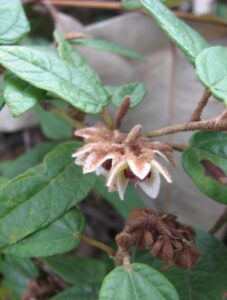
Start making ‘scents’
Beverley has also heard of some unusual methods for deterring herbivores from grazing plants based on those animals’ sense of smell. One strategy involves the use of dingo and fox urine on plants. These commodities are hard to come by, especially here in Tasmania! Other recommendations include hanging bags of blood and bone or stockings of Dynamic Lifter, spraying menthol concoctions on trees, or planting garlic and chilli amongst plants likely to be grazed.
Whilst the efficacy of these management techniques requires further testing, the idea that smell may deter grazing does have merit. University of Sydney researchers recently discovered that herbivores primarily use their sense of smell to tell which plants they want to eat or avoid11. These researchers found that native tree seedlings were twenty times less likely to be eaten when surrounded by vials containing scent extracted from Boronia pinnata (Pinnate Boronia), a plant that wallabies are known to avoid, than when surrounded by the study’s controls. The researchers claim that this was equivalent to using real B. pinnata plants, but better because vials do not compete with seedlings for water and other resources, as real plants can. However, vials do not have the same landscape appeal, so go with the real plants!
Protect the ‘establishment’
When purchasing plants, buy them knowing that they will need to be protected until they are established. “Buying plants that are already at a mature size can discourage wildlife from eating those plants. If a plant is a little more established, a little more woody, and has more of its oil content like leptospermums, then it may not be quite so appealing. However, that can cost more,” acknowledges Beverley, “Tubestock are more appealing price-wise; however, they need to be protected to prevent their soft new growth attracting hungry wildlife or from curious animals unintentionally pulling the whole plant out of the ground.”
There are many different tree guards on the market these days, including biodegradable, carton, fluted plastic, polymesh, sleeve and steel mesh types. These guards have generally been developed for revegetation projects; however, they can be used in the residential garden or public landscape. Longer-lasting guards made of steel mesh or bioplastics may be more expensive; however, they can be reused. Corflute and cardboard-based guards are biodegradable but may not stand up well in very wet and windy conditions. Plastic guards can break down quite quickly in very windy conditions and have a relatively short life.
Beverley recommends selecting the tree guard that suits the lifespan of the plants you need to protect. Her final advice to me on this topic, i.e. her golden rule, is that we should protect a plant until its growing tips are out of reach of local wildlife. Wise words indeed!
To further deter wildlife from grazing plants:
- Remember that if a plant is generally safe for humans to consume, then it is probably just as palatable for wildlife. Select and protect those plants accordingly.
- Provide an alternative food source for wildlife by creating a forage garden containing low maintenance plants that they like to eat. “If they are content with that plant selection, then they may not bother the other plants,” says Beverley.
- Plant numerous and diverse varieties of plants at the same time to prevent isolated individuals receiving too much attention.
- Mow lawns regularly to reduce grass cover and deter kangaroos from grazing.
- Reduce lawn size and therefore grazing comfort for local kangaroos and wallabies by increasing coverage of other vegetation.
- Ensure trees are pruned back so possums cannot reach them from the canopy of adjoining trees and fence lines.
- Locate water features such as bird baths away from special plants that wildlife like to eat.
- Install motion activated jet-sprinklers or security lights to deter nighttime grazing. Remember though not to disturb your human neighbours or threatened wildlife at the same time!
- Use non-toxic natural deterrents or commercial deterrents formulated to repel wildlife.
- Remove overnight access to pet food and use a closed compost system to reduce a garden’s attractiveness to wildlife.
Gabrielle Stannus
Inwardout Studio
M: 0400 431 277
E: gabrielle@inwardoutstudio.com
References
- Burrell, S. (2022, April 21). Eastern Grey Kangaroo. Australian Museum. https://australian.museum/learn/animals/mammals/eastern-grey-kangaroo/
- Backyard Buddies. (n.d.). Possums. The Foundation for National Parks & Wildlife. https://backyardbuddies.org.au/backyard-buddies/possums/
- Department of Natural Resources and Environment Tasmania [NRE Tas]. (2024, May 24). Living with Brush-tailed Possums. Tasmanian Government. https://nre.tas.gov.au/wildlife-management/living-with-wildlife/living-with-brush-tailed-possums
- NRE Tas (2020, October 15). Choosing Appropriate Mesh. Tasmanian Government. https://nre.tas.gov.au/wildlife-management/management-of-wildlife/managing-wildlife-browsing-grazing-losses/wallaby-fencing/choosing-appropriate-mesh
- Queensland Government. (2023, July 3). Kangaroos and wallabies. https://www.qld.gov.au/environment/plants-animals/animals/living-with/kangaroos
- Department of Natural Resources and Environment Tasmania. (2024, April 9). Common Wombat. Tasmanian Government. https://nre.tas.gov.au/wildlife-management/fauna-of-tasmania/mammals/possums-kangaroos-and-wombats/wombat
- Divljan, A. (2022, April 21). Bare-nosed Wombat. Australian Museum. https://australian.museum/learn/animals/mammals/bare-nosed-wombat/
- University of Tasmania. (2019). Lasiopetalum macrophyllum. Key to Tasmanian Vascular Plants. https://www.utas.edu.au/dicotkey/dicotkey/Malv/sLasiopetalum_macrophyllum.htm
- Australian Native Plants Society (Australia). (n.d.). Grevillea – Cultivation. https://anpsa.org.au/genera/grevillea/
- Jones, C. (2009). Grevilleas as Plant Allergens. Australian Plants Online. Australian Native Plants Society (Australia). https://anpsa.org.au/APOL2009/mar09-s1.html
- Finnerty, P., McArthur, C. & Banks, P. (2024). Animals keep eating precious plants – we used ‘smell misinformation’ to keep them away. The Conversation. https://theconversation.com/animals-keep-eating-precious-plants-we-used-smell-misinformation-to-keep-them-away-215454
